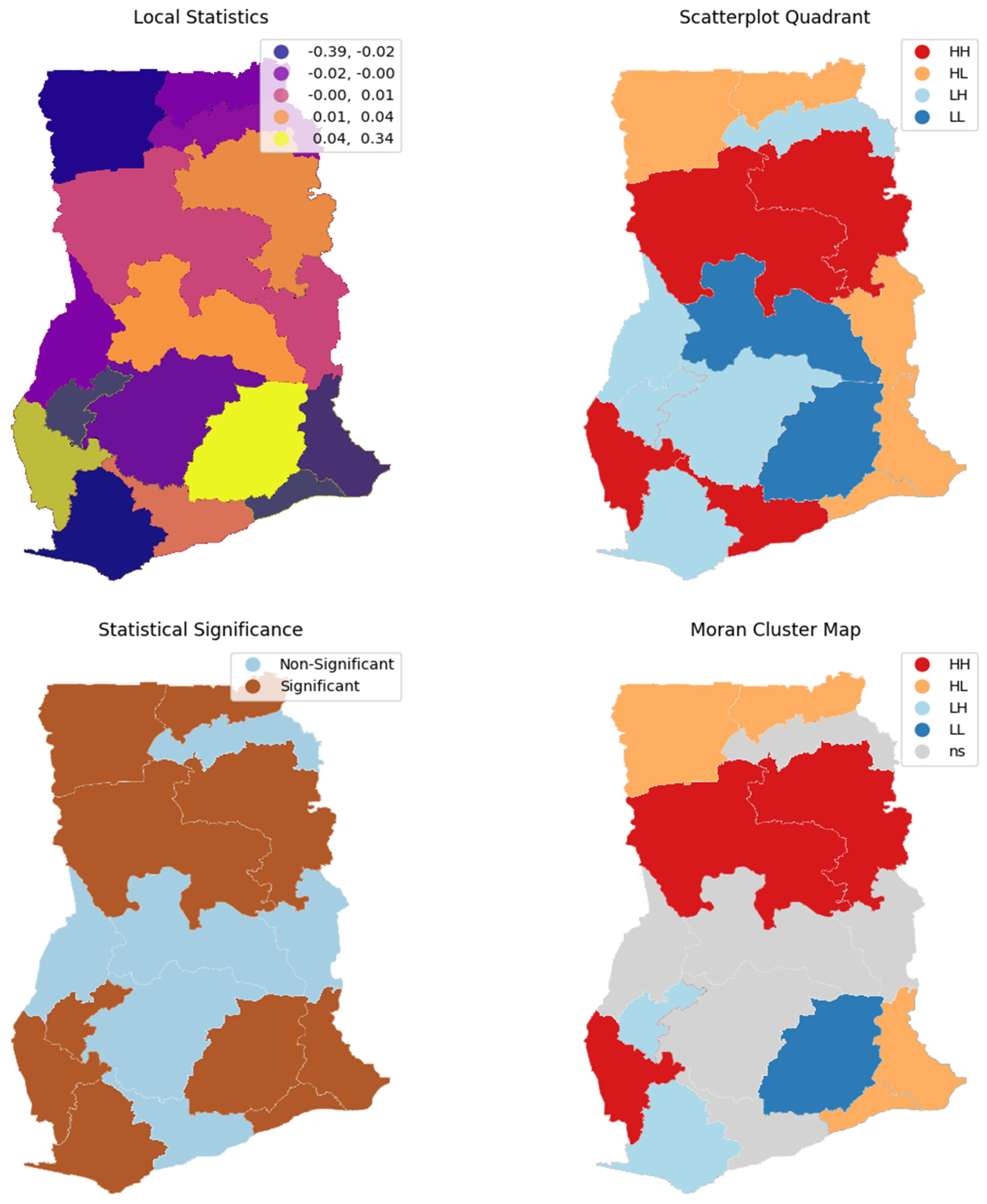Spatial Analysis of Metabolic Equivalents of Task Among Females in Urban and Rural Ghana
Abstract
1. Introduction
2. Materials and Methods
2.1. Context
2.2. Data and Data Source
2.3. Variables, Covariates, Inclusion and Exclusion Criteria
2.3.1. Variables and Covariates
2.3.2. Inclusion and Exclusion Criteria

2.4. Statistical Analysis
2.4.1. Descriptive Analysis
2.4.2. Inferential Analysis
3. Results
4. Discussion
4.1. Implications of the Study
4.2. Limitations and Future Research
5. Conclusions
Funding
Institutional Review Board Statement
Informed Consent Statement
Data Availability Statement
Acknowledgments
Conflicts of Interest
Abbreviations
| BMI | Body Mass Index |
| DHS | Demographic and Health Survey |
| GDHS | Ghana Demographic and Health Survey |
| HH | High–High |
| HL | High–Low |
| LH | Low–High |
| LISA | Local Indicators of Spatial Association |
| LL | Low–Low |
| LMICs | Low- and Middle-Income Countries |
| METS | Metabolic Equivalent |
References
- Hölzel, C.; Weidhase, L.; Petros, S. The Effect of Age and Body Mass Index on Energy Expenditure of Critically Ill Medical Patients. Eur. J. Clin. Nutr. 2021, 75, 464–472. [Google Scholar] [CrossRef] [PubMed]
- Dhuli, K.; Naureen, Z.; Medori, M.C.; Fioretti, F.; Caruso, P.; Perrone, M.A.; Nodari, S.; Manganotti, P.; Xhufi, S.; Bushati, M.; et al. Physical Activity for Health. J. Prev. Med. Hyg. 2022, 63, E150–E159. [Google Scholar] [CrossRef]
- Lee, I.-M.; Shiroma, E.J.; Lobelo, F.; Puska, P.; Blair, S.N.; Katzmarzyk, P.T. Impact of Physical Inactivity on the World’s Major Non-Communicable Diseases. Lancet 2012, 380, 219–229. [Google Scholar] [CrossRef] [PubMed]
- Strain, T.; Dempsey, P.C.; Wijndaele, K.; Sharp, S.J.; Kerrison, N.; Gonzales, T.I.; Li, C.; Wheeler, E.; Langenberg, C.; Brage, S.; et al. Quantifying the Relationship Between Physical Activity Energy Expenditure and Incident Type 2 Diabetes: A Prospective Cohort Study of Device-Measured Activity in 90,096 Adults. Diabetes Care 2023, 46, 1145–1155. [Google Scholar] [CrossRef] [PubMed]
- Haskell, W.L.; Lee, I.-M.; Pate, R.R.; Powell, K.E.; Blair, S.N.; Franklin, B.A.; Macera, C.A.; Heath, G.W.; Thompson, P.D.; Bauman, A. Physical Activity and Public Health: Updated Recommendation for Adults from the American College of Sports Medicine and the American Heart Association. Med. Sci. Sports Exerc. 2007, 39, 1423–1434. [Google Scholar] [CrossRef]
- Jetté, M.; Sidney, K.; Blümchen, G. Metabolic Equivalents (METS) in Exercise Testing, Exercise Prescription, and Evaluation of Functional Capacity. Clin. Cardiol. 1990, 13, 555–565. [Google Scholar] [CrossRef]
- National Cancer Institute, Division of Cancer Control and Population Sciences. Metabolic Equivalent of Task Values for Activities in American Time Use Survey and 2002 Census Occupational Classification System. Available online: https://epi.grants.cancer.gov/physical/met/ocs-met.php (accessed on 22 April 2025).
- Silva, T.O.; Norde, M.M.; Vasques, A.C.; Zambom, M.P.; Antonio, M.A.R.d.G.M.; Rodrigues, A.M.D.B.; BRAMS Group; Geloneze, B.; Brazilian Metabolic Syndrome Study Investigators. Association of Physical Activity and Sitting with Metabolic Syndrome and Hyperglycemic Clamp Parameters in Adolescents—BRAMS Pediatric Study. Front. Endocrinol. 2023, 14, 1191935. [Google Scholar] [CrossRef]
- del-Cuerpo, I.; Jerez-Mayorga, D.; Chirosa-Ríos, L.J.; Morenas-Aguilar, M.D.; Mariscal-Arcas, M.; López-Moro, A.; Delgado-Floody, P. Males Have a Higher Energy Expenditure than Females during Squat Training. Nutrients 2023, 15, 3455. [Google Scholar] [CrossRef]
- Edwards, E.S.; Sackett, S.C. Psychosocial Variables Related to Why Women Are Less Active than Men and Related Health Implications. Clin. Med. Insights Womens Health 2016, 9, 47–56. [Google Scholar] [CrossRef]
- Yu, X.; Hao, L.; Crainiceanu, C.; Leroux, A. Occupational Determinants of Physical Activity at Work: Evidence from Wearable Accelerometer in 2005–2006 NHANES. SSM—Popul. Health 2021, 17, 100989. [Google Scholar] [CrossRef]
- Nin-Pratt, A.; McBride, L. Agricultural Intensification in Ghana: Evaluating the Optimist’s Case for a Green Revolution. Food Policy 2014, 48, 153–167. [Google Scholar] [CrossRef]
- Ghana Statistical Service Third Quarter Labour Force Report. Available online: https://statsghana.gov.gh/gssmain/fileUpload/pressrelease/AHIES%20QUARTER%203%202022%20LABOUR_STATISTICS_REPORT.pdf (accessed on 22 April 2025).
- Abane, A.M.; Mariwah, S.; Owusu, S.A.; Kasim, A.; Robson, E.; Hampshire, K. Mobile Phone Use and the Welfare of Community Health Nurses in Ghana: An Analysis of Unintended Costs. World Dev. Perspect. 2021, 23, 100317. [Google Scholar] [CrossRef] [PubMed]
- Atorkey, P.; Owiredua, C.; Mohammed, Z.; Gyimah, F.T. Physical Activity and Sedentary Behaviour Research in Ghana: A Systematic Review Protocol. Glob. Epidemiol. 2019, 1, 100010. [Google Scholar] [CrossRef]
- Radoine, H.; Bajja, S.; Dakyaga, F.; Çelik, A.; Kamana, A.; Yakubu, H.; Chenal, J. Modelling the Dynamics of Urbanization for Urban Sustainability in West Africa. J. Urban Manag. 2024, 13, 580–595. [Google Scholar] [CrossRef]
- The DHS Program The DHS Program—Datasets Account Home. Available online: https://dhsprogram.com/data/dataset_admin/index.cfm (accessed on 22 April 2025).
- USAID The DHS Program—Available Datasets. Available online: https://dhsprogram.com/data/available-datasets.cfm (accessed on 5 September 2024).
- Nolan, L.B.; Lucas, R.; Choi, Y.; Fabic, M.S.; Adetunji, J.A. The Contribution of Demographic and Health Survey Data to Population and Health Policymaking: Evidence from Three Developing Countries. Afr. Popul. Stud. 2017, 31, 3395–3407. [Google Scholar] [CrossRef][Green Version]
- Short Fabic, M.; Choi, Y.; Bird, S. A Systematic Review of Demographic and Health Surveys: Data Availability and Utilization for Research. Bull. World Health Organ. 2012, 90, 604–612. [Google Scholar] [CrossRef]
- SimpleMaps Free GIS Maps of Ghana—Resources | Simplemaps.Com. Available online: https://simplemaps.com/gis/country/gh#admin1 (accessed on 22 April 2025).
- Berghoff, A.S.; Schur, S.; Füreder, L.M.; Gatterbauer, B.; Dieckmann, K.; Widhalm, G.; Hainfellner, J.; Zielinski, C.C.; Birner, P.; Bartsch, R.; et al. Descriptive Statistical Analysis of a Real Life Cohort of 2419 Patients with Brain Metastases of Solid Cancers. ESMO Open 2016, 1, e000024. [Google Scholar] [CrossRef]
- Vetter, T.R. Descriptive Statistics: Reporting the Answers to the 5 Basic Questions of Who, What, Why, When, Where, and a Sixth, So What? Anesth. Analg. 2017, 125, 1797–1802. [Google Scholar] [CrossRef]
- Tuan, S.; Su, H.; Chen, Y.; Li, M.; Tsai, Y.; Yang, C.; Lin, K. Fat Mass Index and Body Mass Index Affect Peak Metabolic Equivalent Negatively during Exercise Test among Children and Adolescents in Taiwan. Int. J. Environ. Res. Public Health 2018, 15, 263. [Google Scholar] [CrossRef]
- Tudor-Locke, C.; Ainsworth, B.E.; Washington, T.L.; Troiano, R. Assigning Metabolic Equivalent Values to the 2002 Census Occupational Classification System. J. Phys. Act. Health 2011, 8, 581–586. [Google Scholar] [CrossRef]
- Simmons, S.S. Strikes and Gutters: Biomarkers and Anthropometric Measures for Predicting Diagnosed Diabetes Mellitus in Adults in Low- and Middle-Income Countries. Heliyon 2023, 9, e19494. [Google Scholar] [CrossRef]
- Bjornlund, V.; Bjornlund, H.; Van Rooyen, A.F. Why Agricultural Production in Sub-Saharan Africa Remains Low Compared to the Rest of the World—A Historical Perspective. Int. J. Water Resour. Dev. 2020, 36, S20–S53. [Google Scholar] [CrossRef]
- Teklu, T.; Asefa, S. Who Participates in Labor-Intensive Public Works in Sub-Saharan Africa? Evidence from Rural Botswana and Kenya. World Dev. 1999, 27, 431–438. [Google Scholar] [CrossRef]
- Flood, D.; Geldsetzer, P.; Agoudavi, K.; Aryal, K.K.; Brant, L.C.C.; Brian, G.; Dorobantu, M.; Farzadfar, F.; Gheorghe-Fronea, O.; Gurung, M.S.; et al. Rural-Urban Differences in Diabetes Care and Control in 42 Low- and Middle-Income Countries: A Cross-Sectional Study of Nationally Representative Individual-Level Data. Diabetes Care 2022, 45, 1961–1970. [Google Scholar] [CrossRef]
- Oruç, E.; Çağlar, İ. The Relationship between Tendency of Rural Population to Work in Non-Agricultural Jobs and Some Socio-Economic Factors (Example of Tokat Kazova Great Plain Conservation Area). J. Rural Stud. 2022, 92, 50–55. [Google Scholar] [CrossRef]
- File, D.J.M.-B.; Nhamo, G. Farmers’ Choice for Indigenous Practices and Implications for Climate-Smart Agriculture in Northern Ghana. Heliyon 2023, 9, e22162. [Google Scholar] [CrossRef] [PubMed]
- Racine, E.F.; Laditka, S.B.; Dmochowski, J.; Alavanja, M.; Lee, D.; Hoppin, J.A. Farming Activities and Carrying and Lifting: The Agricultural Health Study. J. Phys. Act. Health 2012, 9, 39–47. [Google Scholar] [CrossRef]
- Ferreira, V.; Almazán-Gómez, M.Á.; Nechifor, V.; Ferrari, E. The Role of the Agricultural Sector in Ghanaian Development: A Multiregional SAM-Based Analysis. J. Econ. Struct. 2022, 11, 6. [Google Scholar] [CrossRef]
- Addo, P.N.O.; Nyarko, K.M.; Sackey, S.O.; Akweongo, P.; Sarfo, B. Prevalence of Obesity and Overweight and Associated Factors among Financial Institution Workers in Accra Metropolis, Ghana: A Cross Sectional Study. BMC Res. Notes 2015, 8, 599. [Google Scholar] [CrossRef]
- Asosega, K.A.; Adebanji, A.O.; Abdul, I.W. Spatial Analysis of the Prevalence of Obesity and Overweight among Women in Ghana. BMJ Open 2021, 11, e041659. [Google Scholar] [CrossRef]
- Kwasi Ofosu, D. Assessing the Spatial Distribution of Health Facilities in the Eastern Region of Ghana. Doctoral Dissertation, Kwame Nkrumah University of Science and Technology, Kumasi, Ghana, 2012. [Google Scholar]
- Songsore, J. The Urban Transition in Ghana: Urbanization, National Development and Poverty Reduction. Ghana Soc. Sci. J. 2020, 17, 57. [Google Scholar]
- Aboagye, P.Y.; Bolt, J. Long-Term Trends in Income Inequality: Winners and Losers of Economic Change in Ghana, 1891–1960. Explor. Econ. Hist. 2021, 82, 101405. [Google Scholar] [CrossRef]




| Occupation Type | METs |
|---|---|
| Salespersons, demonstrators and models | 1.5 |
| Sales and services, elementary occupations | 2.5 |
| Other craft and related workers | 4 |
| Personal and protective services workers | 3.5 |
| Not working and did not work in last 12 months | 1.5 |
| Other associate professionals | 2.3 |
| Teaching professionals | 2.5 |
| Market-oriented skilled agricultural and fishery workers | 5 |
| Agricultural, fishery and related labourers | 5.5 |
| Precision, handicraft, printing and related trades workers | 3.5 |
| Life science and health professionals | 2 |
| Stationary machine operators and assemblers | 3 |
| Customer services clerks | 2 |
| General managers | 1.5 |
| Office clerks | 2 |
| Physical science and engineering associate professionals | 2.2 |
| Life science and health associate professionals | 2 |
| Labourers in mining, construction, manufacturing and transport | 6 |
| Corporate managers | 1.5 |
| Other professionals | 2.3 |
| Extraction and building trades workers | 6 |
| Physical, mathematical and engineering science professionals | 2 |
| Drivers and mobile machine operators | 3 |
| Subsistence agricultural, fishery and related workers | 5.5 |
| Industrial plant operators | 3 |
| Metal and machinery trades workers | 5 |
| Urban | Rural | |
|---|---|---|
| Total (%) | Total (%) | |
| 6829 (49.489) | 6970 (50.511) | |
| Indicators | ||
| ± SD | ± SD | |
| Age | 29.657 ± 9.726 | 29.560 ± 9.922 |
| BMI | 25.304 ± 4.854 | 23.467 ± 3.891 |
| BMI (imputed) | 25.313 ± 4.854 | 23.476 ± 3.888 |
| METs values | 2.415 ± 1.208 | 3.351 ± 1.627 |
| Total (%) | Total (%) | |
| Education | ||
| No education | 919 (13.457) | 2150 (30.846) |
| Primary | 813 (11.905) | 1233 (17.690) |
| Secondary | 4164 (60.975) | 3328 (47.747) |
| Tertiary/Higher | 933 (13.662) | 259 (3.716) |
| Wealth | ||
| Poorest | 323 (4.730) | 3001 (43.056) |
| Poorer | 993 (14.541) | 2105 (30.201) |
| Middle | 1810 (26.505) | 975 (13.989) |
| Richer | 1905 (27.896) | 568 (8.149) |
| Richest | 1798 (26.329) | 321 (4.605) |
| Regions | ||
| Ahafo | 387 (5.667) | 400 (5.739) |
| Ashanti | 610 (8.932) | 445 (6.385) |
| Bono | 442 (6.472) | 317 (4.548) |
| East | 484 (7.087) | 425 (6.098) |
| Central | 494 (7.234) | 416 (5.968) |
| Eastern | 436 (6.385) | 350 (5.022) |
| Greater Accra | 740 (10.836) | 164 (2.353) |
| Northeast | 351 (5.140) | 513 (7.360) |
| Northern | 525 (7.688) | 519 (7.446) |
| Oti | 333 (4.876) | 511 (7.331) |
| Savannah | 343 (5.023) | 556 (7.977) |
| Upper East | 312 (4.569) | 585 (8.393) |
| Upper West | 312 (4.569) | 576 (8.264) |
| Volta | 376 (5.506) | 401 (5.753) |
| Western | 398 (5.828) | 340 (4.878) |
| Western North | 286 (4.188) | 452 (6.485) |
| Global Statistics | |||
|---|---|---|---|
| General Population | Urban Population | Rural Population | |
| Moran’s I | 0.003 | 0.002 | 0.004 |
| z-value | 15.880 | 4.927 | 14.514 |
| p-value | 0.001 | 0.002 | 0.001 |
Disclaimer/Publisher’s Note: The statements, opinions and data contained in all publications are solely those of the individual author(s) and contributor(s) and not of MDPI and/or the editor(s). MDPI and/or the editor(s) disclaim responsibility for any injury to people or property resulting from any ideas, methods, instructions or products referred to in the content. |
© 2025 by the author. Licensee MDPI, Basel, Switzerland. This article is an open access article distributed under the terms and conditions of the Creative Commons Attribution (CC BY) license (https://creativecommons.org/licenses/by/4.0/).
Share and Cite
Simmons, S.S. Spatial Analysis of Metabolic Equivalents of Task Among Females in Urban and Rural Ghana. Obesities 2025, 5, 33. https://doi.org/10.3390/obesities5020033
Simmons SS. Spatial Analysis of Metabolic Equivalents of Task Among Females in Urban and Rural Ghana. Obesities. 2025; 5(2):33. https://doi.org/10.3390/obesities5020033
Chicago/Turabian StyleSimmons, Sally Sonia. 2025. "Spatial Analysis of Metabolic Equivalents of Task Among Females in Urban and Rural Ghana" Obesities 5, no. 2: 33. https://doi.org/10.3390/obesities5020033
APA StyleSimmons, S. S. (2025). Spatial Analysis of Metabolic Equivalents of Task Among Females in Urban and Rural Ghana. Obesities, 5(2), 33. https://doi.org/10.3390/obesities5020033





